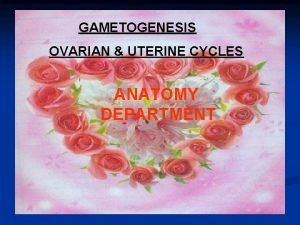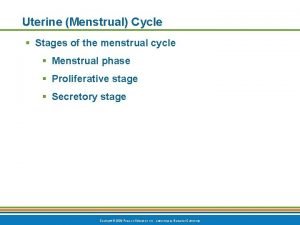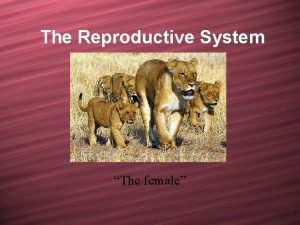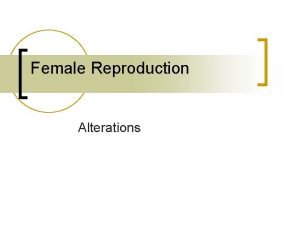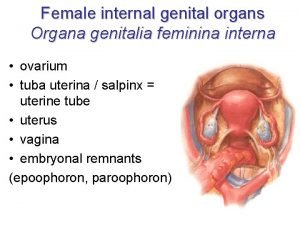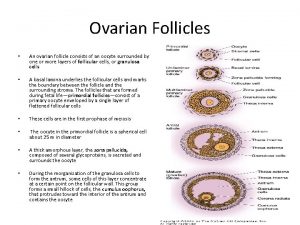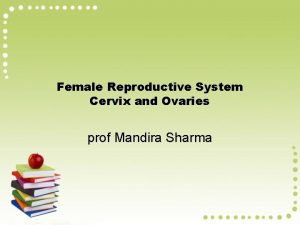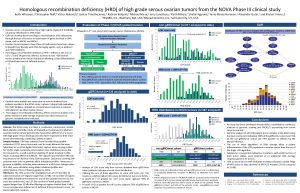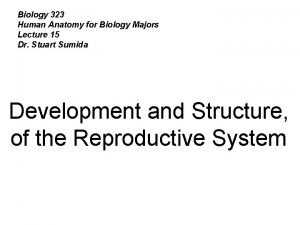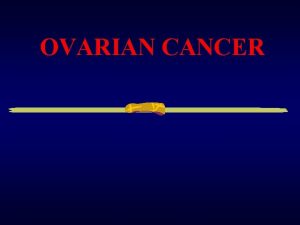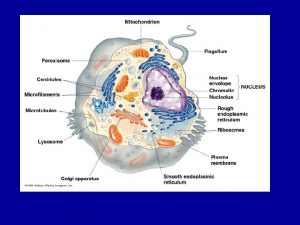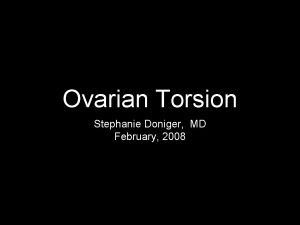Ovarian cycle Ovarian cycle It occurs in the

















- Slides: 17

Ovarian cycle

❖ Ovarian cycle - It occurs in the cortex of ovary and started after puberty. - Each ovary functions alternatively every other month. - It is repeated every lunar month (every 28 days) till menopause. ▪ At birth, the ovary contains about two million primary oocyte. Thereafter most of them degenerate and, by puberty, when ovulation begins only about 40, 000 primary oocytes are left in the ovary. - During each cycle 10 -15 primary follicles developed but one or more continue and other atrophied.

∙ Stages of the ovarian cycle: (I) Changes in the cortex of the ovary: - The cortical cells proliferated and differentiated into 2 layers. a) Outer layer (theca externa): is a fibrous layer and has protective function. b) Inner layer (theca interna): It is highly vascular, and secrets estrogen hormone.

Primary follicle Zona pellucida Granulosa cells Growing follicle (II) Changes in the primary follicle; - Each primary follicle consists of one primary oocyte surrounded by a single layer of flat cells called follicular cells. - 1 - Formation of the growing follicle: A- The primary oocyte completes the 1 st meiotic division to form secondary oocyte (23 chromones 22+x) and 1 st polar body (23 chromones 22+x). B- Changes in the follicular cells: - The follicular cells are changed from flat cells to cuboidal cells ﻣﻜﻌﺐ. - The cells proliferate forming many layers of cells called granulosa cells. - These cells form a transparent membrane around the secondary oocyte called zona pellucida ﺍﻟﻤﻨﻄﻘﺔ ﺍﻟﺸﻔﺎﻓﺔ.

2 - Formation of the Graafian follicle: - A sickle-shaped cavity develops between the granulosa cells called antrum ﻏﺎﺭ. - This antrum divides the granulosa cells into 2 groups; a- An outer layer called stratum granulosum ﺍﻟﻄﺒﻘﺔ ﺍﻟﺤﺒﻴﺒﻴﺔ. b- An inner layer called cumulus ovaricus ﺍﻟﺮﻛﺎﻡ ﺍﻟﻤﺒﻴﻀﻲ. The secondary oocyte is surrounded by zone pellucida

3 - Stage of ovulation: under LH (luteinizing hormone) - Ruptures of the Graafian follicle and ovulation occurs due to: a- Excessive accumulation of fluid in the antrum leading to increase of the pressure inside the follicle a. The straum granulosum , theca interna , externa and capsule of the ovary is elevated , thinned and become a vascular and rupture

** Results of ovulation: A- Discharge of secondary oocyte and 1 st polar body, surrounded by zona pellucida and cumulus ovaricus which now called corona radiata cells. ﺍﻟﺘﺎﺝ ﺍﻟﻤﺸﻊ • B- The cavity of rupture Graafian follicle is filled by blood and is called corpus hemorrhagicum. • Later on iron deposited in the follicular cells that become yellow and called corpus luteum. ﺍﻟﺠﺴﻢ ﺍﻷﺼﻔﺮ The corpus luteum secrets estrogen and progesterone.

4 – post ovulation changes If the fertilization occurs If the fertilization does not occur Formation of the zygote The secondary oocyte has a 24 -hour lifespan , in some cases can be extended up to 48 h then degenerated Enlarged of corpus luteum and continues to secrete estrogen and progesterone hormones till the 4 th-6 th month of pregnancy. After 6 months , it degenerates and its function being carried by placenta The corpus luteum continues to secrete estrogen and progesterone for 10 daysthen degenerated and called corpus albicans ﺍﻟﺠﺴﻢ ﺍﻻﺑﻴﺾ Inhibition of further ovulation due to inhibition and progesterone hormones secreted from the corpus luteum The endometrium of the utherus becomes more vascular , thickened and its gland are filled by secretion and now called decidua Another ovarian cycle begins ( decrease of estrogen & prodesterone stimulates production of FSH ) Spasm of spiral arteries of the endometrium of the uterus resulting in shedding of the endometrium ﻳﺘﺴﺎﻗﻂ and menstruation occyrs

- - ❖ The time of ovulation It is about 14 th day of the cycle The ovulation is characterized by: 1. Increased the basal body temperature (36. 5 -37) of the female by 1/2 - l Celsius. 2. Increase of the vaginal mucus secretion like egg white, stretch between your fingers (the amount varies from woman to woman). 3. A more sensitive sense of smell 4. Tender of the breast 5. Lower abdominal pain in the side of the active ovulation. 6. Some woman notice that their sex drive increases during ovulation (woman is more attracted to the male) 7. The cervix becomes more higher, softer and more opened 8. Elevation of luteinizing hormone (detected in urine) and estrogen hormone It can differ from woman to woman (If you do notice any signs, do not worry (most woman have no clue)

❖ Hormonal control of the ovarian cycle • During the 1 st half of the cycle: - Anterior pituitary gland secretes follicular stimulating hormone (F. S. H. ) that causes 1. Changes of the primary follicle to growing follicle and Graafian follicle. 2. Secretion of estrogen hormone. • In the middle of the cycle: - Stop secretion of F. S. H. - Estrogen stimulates pituitary gland to produce luteinizing hormone (LH) that causes: 1. Ovulation (rupture of Graafian follicle) 2. Formation of corpus luteum that secrets progesterone and a small amount of estrogen in the second half of the cycle. Corpus luteum secrets progesterone and a small amount of estrogen

Uterine cycle Fundes Body cervix Vagina vulva

∙ Uterine (menstrual) cycle - The uterus is a hollow thick – walled muscular organ - The wall of the uterus is formed of three layers from innermost to outermost ( endometrium , myometrium and perimetrium ) - During each ovarian cycle, the endometrium of the fundus and body of the uterus also undergoes cyclic changes that end in hemorrhage (menstruation). - The duration of the menstrual cycle is about 28 days Starting from the first day of hemorrhage. - The first cycle at puberty is called menarche. (about 11 -14 years ) - The cycle end at menopause age. ( about 45 -55 years )

❖ Stages of the uterine (menstrual) cycle Base of gland Blood Basal part of uterine gland (I) Stage of menstruation (bleeding): ** Duration about 3 -5 days. ** Causes: Sudden drop of the estrogen and progesterone levels in the blood due to degeneration of corpus luteum leading to spasm of the spiral arteries. ** It consists of blood and pieces of endometrium ** Blood does not clot due to its high contents of fibrinolytic enzymes. ** Structure of the endometrium: - It is formed of basal layer. - Its thickness is about 0. 5 mm.

❖ Stages of the uterine (menstrual) cycle Base of gland Flat cells (II) Stage of repair ﺇﺻﻼﺡ : - Duration about 3 -4 days - The cells of the basal part of the uterine glands proliferate and migrate to cover the raw surface of the endometrium by flat cells. ** Causes: the effect of estrogen hormone secreted from the ovary.

❖ Stages of the uterine (menstrual) cycle Uterine gland Spiral artery (Ill) Stage of proliferation: ** Duration: about 5 -6 days. ** The endometrium shows the following changes: 1 - The endometrial cells become cuboidal. 2 - The endometrial glands are longer and straight about 4 mm. 3 - The spiral arteries become longer and straight. ** Causes: the effect of estrogen hormone secreted from the ovary.

(IV) Stage of secretion: ** Duration: about 10 -14 days. ** Causes: it is under the control of progesterone hormone secreted by the corpus luteum ﺍﻟﺠﺴﻢ ﺍﻻﺻﻔﺮ. Compact Layer Spongy Layer Basal Layer Spiral artery ** The endometrium shows the following changes: 1 - The endometrial cells become highly columnar. 2 - The endometrial glands become highly tortuous and filled with mucus and glycogen (uterine milk). 3 - The spiral arteries become more dilated and tortuous. 4 - The thickness is increased about 5 -7 mm. 5 - The endometrium is formed by 3 layers i) Superficial compact layer: contains apices of the glands. ii) Middle spongy layer: contains the main part of the glands. - The above 2 layers are supplied by spiral arteries that are estrogen dependent. These layers are only lost with spasm of these arteries. i) Deep basal layer: containing the basal part of the uterine glands. ∙ This layer is supplied by the basal (straight) arteries.

• • • ❖ What are some of the sympotoms of a normal menstruation ? abdominal cramps, lower back pain bowel issues, fluid cravings headache and fluid retention trouble sleeping, mood swings and irritability fatigue acne tender breast 1. Dysmenorrhea (painful). 2. Menorrhagia: severe bleeding. 3. Amenorrhea: no period.
 Ovarian cycle
Ovarian cycle Uterus
Uterus Ovarian cycle
Ovarian cycle Benjamin cummings
Benjamin cummings The ovarian cycle
The ovarian cycle Fuctions of ovary
Fuctions of ovary Female reproductive system
Female reproductive system Ovarian cancer marker
Ovarian cancer marker Ovarian cyst rupture discharge look like
Ovarian cyst rupture discharge look like Vesicular (graafian) follicle
Vesicular (graafian) follicle Organa genitalia feminina nedir
Organa genitalia feminina nedir Ovarian cancer causes
Ovarian cancer causes Ovarian follicle
Ovarian follicle Ovarian cyst
Ovarian cyst Ovarian teratoma
Ovarian teratoma Ovarian cancer brca
Ovarian cancer brca Hrd score ovarian cancer
Hrd score ovarian cancer Duck penis
Duck penis


